Bringing the desi back into cotton
The glorious muslin that brought fame and fortune to the Indian subcontinent in ancient times was woven out of a short stapled indigenous cotton. Sadly, that cotton is lost to the world. But, a project in Tamil Nadu is reviving another variety of the short staple cotton.

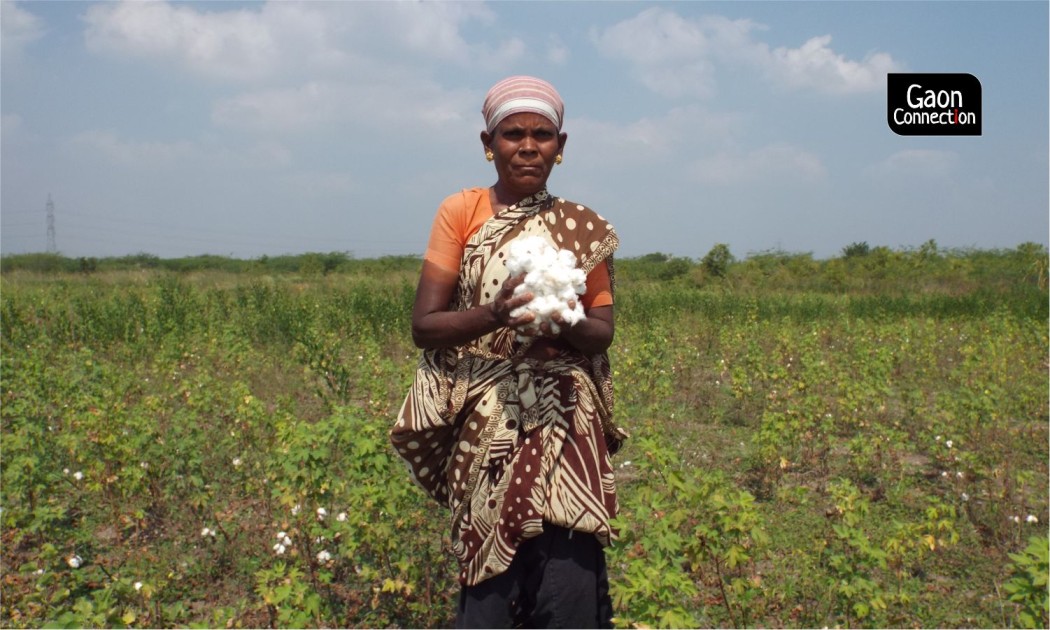
Harvesting the karunganni cotton, that grows along with other food crops in the rainfed district of Dindigul, Tamil Nadu. Photo: V Swaminathan
Karisalpatti, Tamil Nadu
It is noon in Karisalpatti. The sky is a relentless blue and the few scattered white clouds match the checks on the lungi of S Vincent Xavier. The sun beats down sharply as the 33-year-old farmer surveys his three acres (1.2 hectares) where he cultivates karunganni, an indigenous and organic short staple variety of cotton. The cotton will be ready to harvest just after Puthandu, or the Tamil New Year.
Xavier and 11 other farmers in the Dindigul belt are growing karunganni in 20 acres (8.09 hectares) of land that has distinctively black soil, considered perfect for growing cotton. They are part of an experiment to revive the old world cotton value chain that Gandhi envisaged all those years ago, V Swaminathan, who is spearheading the project, told Gaon Connection. The initiative began in 2015-16 at Dindigul district of Tamil Nadu, about 450 kilometres (kms) south west of the state capital Chennai.
“I am trying to work out the bottlenecks and prove that it makes sense to cultivate this tough desi variety of cotton. It has withstood the vagaries of weather for five thousand years and can continue to do so,” said Swaminatnan, who is managing committee member of Organic Farming Association of India, a non-profit that promotes organic farming across the country.
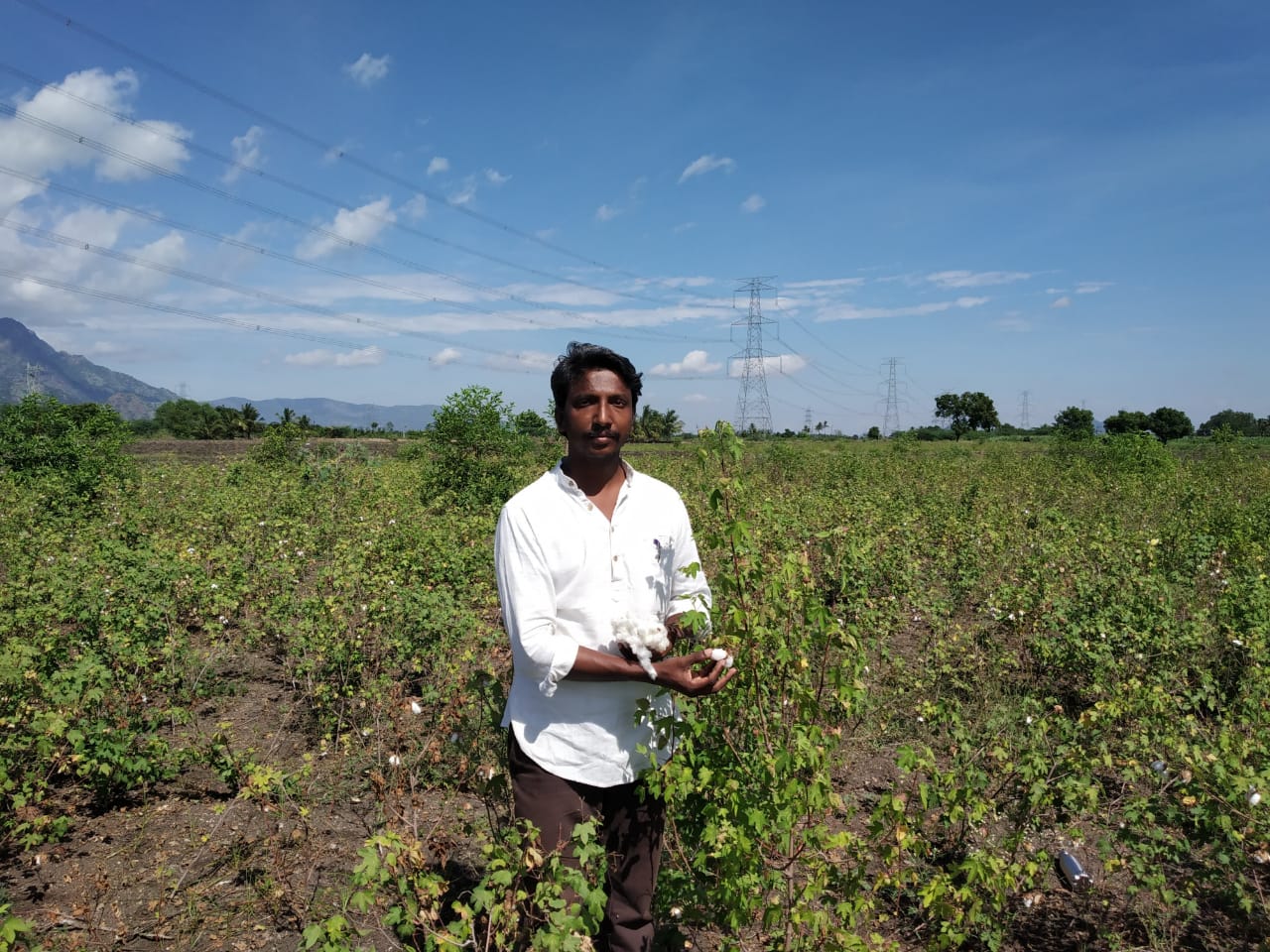
A tattered history
The desi short staple cotton once grew in abundance in the subcontinent for thousands of years. The fine muslins woven from it were poetically described as the ‘mist’, ‘wind’, ‘flowing water,’ and so on, so light and delicate were they. They were woven from a short staple indigenous variety of cotton called phuti karpas grown on the banks of the Meghna and the Buriganga rivers, in present day Bangladesh. But, over the years, the phuti karpas was lost to the world.
The British, who had by then begun weaving textiles in huge machine-run mills back home in Lancashire and Manchester, found that the desi short staple was not suitable for this purpose. To cut a long story short, they forced the Indian farmers to abandon the cultivation of the traditional and indigenous short staple variety, and instead grow the more machine-friendly long stapled ones that could be sent back to their textile mills in England.
The diversity that indigenous cotton varieties offered was, therefore, effectively snuffed off.
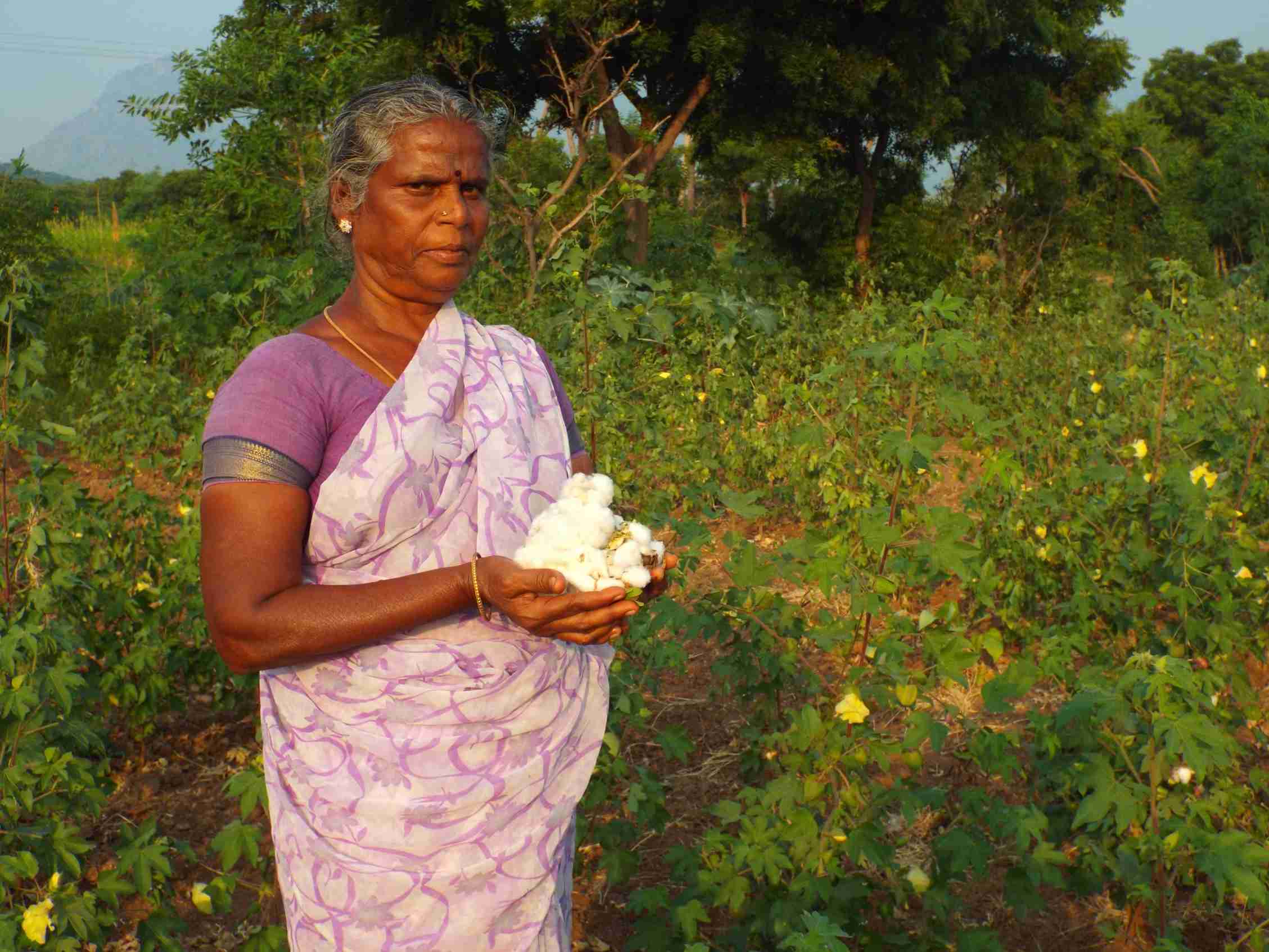
Reviving short staple cotton
Few of the indigenous cotton variety survive, but there are pockets in the country where it still grows. While efforts are underway to revive the famous Dhaka muslin, in India too there are initiatives to bring back the short staple variety.
In Tamil Nadu, a short staple variety called karunganni was widely cultivated in the entirely rainfed tracts of Madurai, Virudhunagar, Thoothukudi, Ramanathapuram and Dindigul districts along with coriander, chickpeas, minor millets, and so on.
In 2015, Swaminathan began working with farmers in the rainfed tracts of Dindigul district to promote the indigenous cotton-based multi cropping system. For nearly six years now the 34-year-old has been on a karunganni cotton mission trying to see if the cultivation, ginning, spinning, and weaving of the karunganni can happen within a geographical area and generate rural livelihood and a sustainable way of life. Something Gandhi envisioned for a self-sufficient and strong village economy.
Also Read: A village that thrived on handloom, Cooch Behar’s Baburhat now has only one handloom mill
“I use the traditional seeds, the same ones my forefather used,” said farmer Xavier. Karunganni has been cultivated in this rainfed area for years, and for a reason. “It is low maintenance, needs no pesticides and flourishes with panchakavya [natural fertilisers] and the seasonal rain,” he explained. The seeds of this variety can be used year after year, unlike those of hybrid cotton.
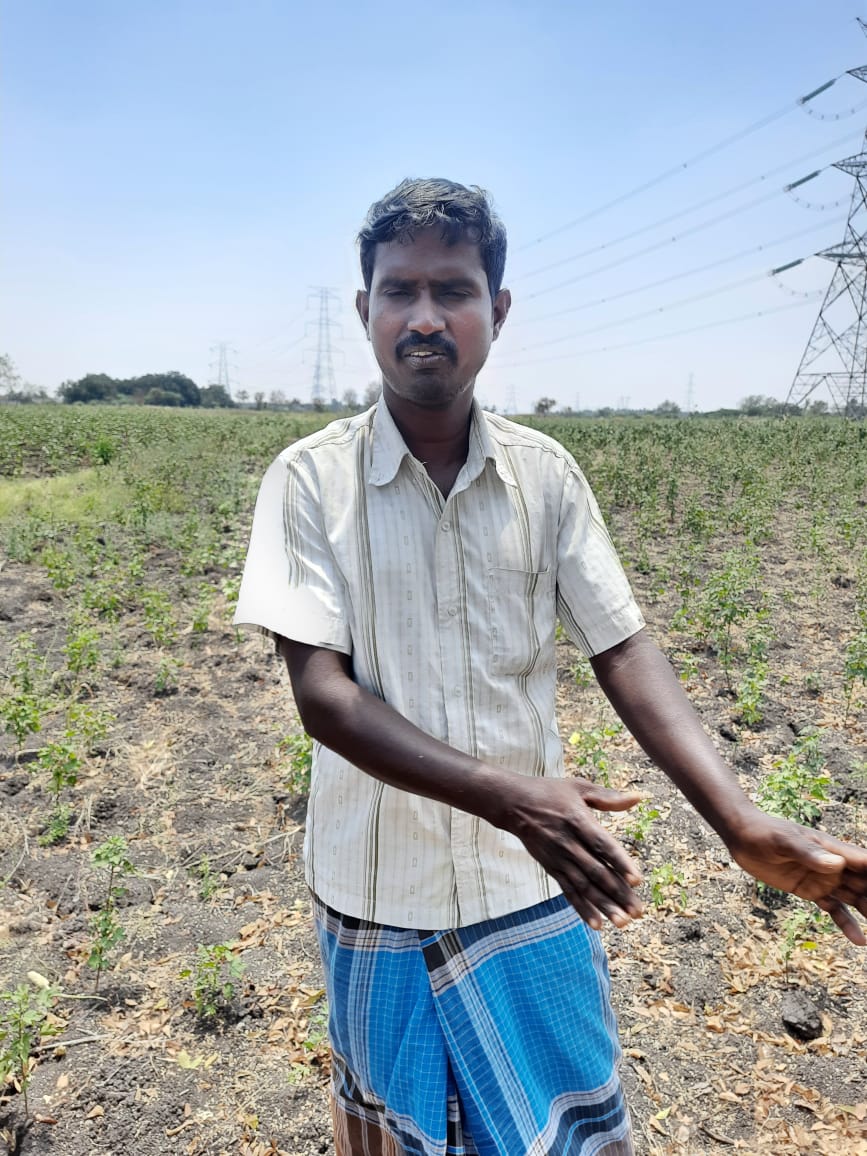
“It also allows us to multi-crop,” R Ganeshan, another farmer who grows karunganni in two acres of land not too far from Xavier’s place, explained to Gaon Connection.
Multi-cropping
On Ganehsan’s two-acre land, there are neat rows of cotton plants, barely knee-high yet, with nodding yellow flowers. One can actually see buds of cotton on some of them. In between grow green tomatoes, chickpeas and coriander. The farmers get an additional income from these. More importantly, they and their families get to eat healthy, pesticide-free food.

The other crops are sown along with the cotton. The coriander is ready for harvest in 45 days, while the chickpea is ready in 90 days. The cotton is ready to harvest in 120 days. This is the seasonal calendar for the food crops.
At Xavier’s home, next to his field, his mother, brother, nephew and a neighbouring farmer sit, legs outstretched on a blue tarpaulin, sieving the soil out of a mound of freshly harvested chickpeas. “We grow vegetables and pulses along with the cotton, ensuring we have enough to eat, and it adds to our income,” Masilamani, Xavier’s mother, told Gaon Connection. This is what our ancestors always did, she said. “Cotton farmers in rainfed areas like ours, traditionally multi-crop,” she added.

That was how cotton cultivation and weaving happened in pre-colonial times, where entire villages were involved in the process. But with colonisation the homespun industry was systematically dismantled and almost destroyed. In their book A Frayed History, The Journey of Cotton in India, Meena Menon and Uzramma, write about the ill-fated journey of Indian cotton that once grew without much fuss in the subcontinent.
And, that is exactly what Swaminathan and his team of farmers are trying to demonstrate. They want to show the world that going back to the basics was a good way to ensure the well being of farmers, weavers and the environment. They want to revive the village economy by making the farm to fabric journey within a contained geographical space.
“To think that there was a time when crafts people accomplished all of the ginning, spinning and weaving processes entirely by hand and produced fabric like the muslins of Dhaka…” commented Swaminathan.
Also Read: An eerie silence prevails in Chanderi. The khat-khat sound of handlooms is a rarity now
From farm to fabric
Once Xavier, Ganeshan and the others harvest the cotton, they send it to Dindigul town, 10 kms away from Karisalpatti for ginning. There, the seeds are separated from the lint with some of the seeds finding their way back to the farmers to be used for the next sowing. The cotton lint goes to a pre-spinning unit at Gandhigram, in Chettyapatti about eight kms away where in big rumbling machines, the cotton is further divested of any impurities and converted into ‘rovings’. Rovings are bundles of fibre drawn out of the lint which is then spun into yarn.
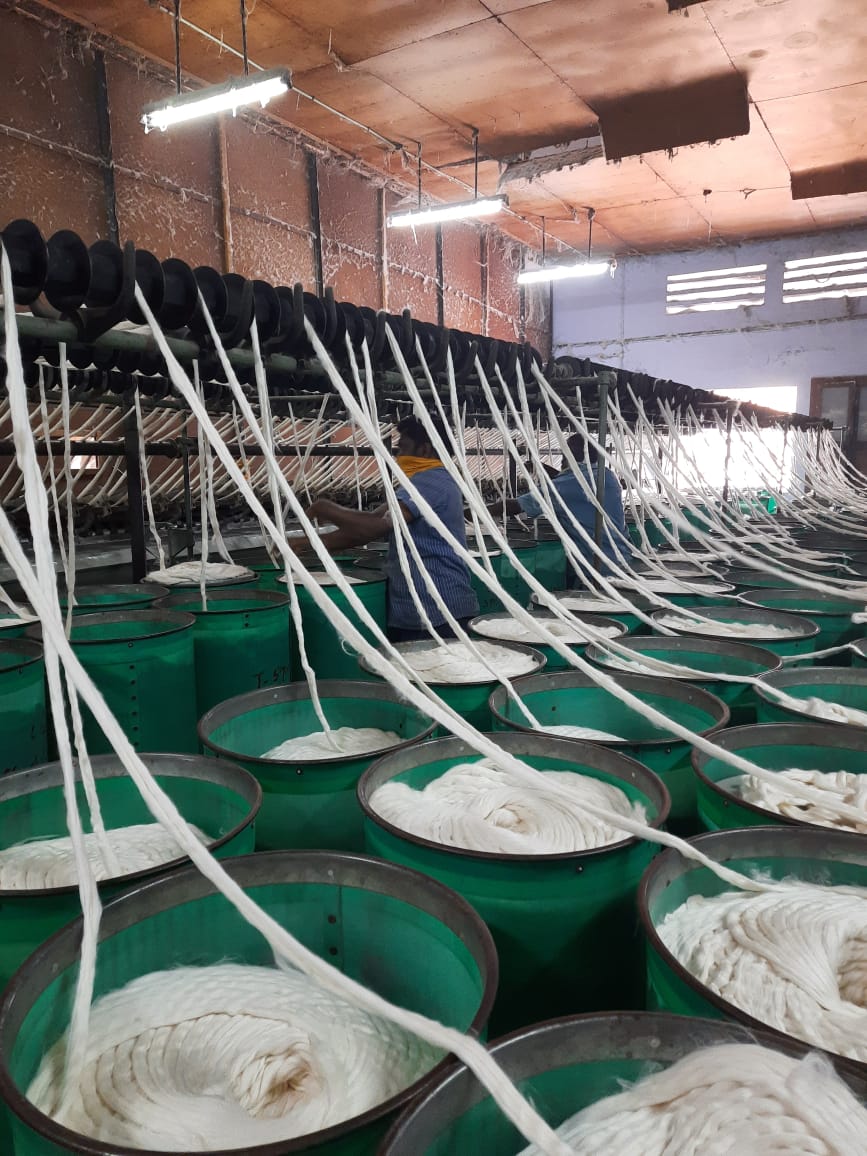
“It was a struggle to make the rovings,” said Swaminathan. The machinery in the large spinning centres in Tamil Nadu is calibrated to take only the long staple cotton, and it was only after a lot of trial and error at the South Indian Textile Research Association (SITRA) in Coimbatore, that they got right the adjustments and the rovings out of the karunganni could be made, at the centre in Gandhigram” explained Swaminathan.
About 20 kms away, at Dharumathupatti village, 19 women sit in a long, airy hall. The rovings from Gandhigram reach them which they then spin into yarns on Ambar charkhas (spinning wheels).

“I have been spinning for twenty nine years,” P Nalamma, 55-year-old, told Gaon Connection. Seated beside her is 47-year-old G Papaathi, her arm moving non stop as she turns the wheel of the charkha. “We work from nine to five,” she said.
It is hard work, but the women say it allows them to sit indoors and do it, much better than working as labourers in the fields. “We earn anything between hundred and fifty to two hundred rupees a day,” Papaathi said. In the room full of women, 33-year-old Velumurugan is the only man. He sits beside his mother, Amaravathi, who leans over every now and then to adjust some setting on his charkha. Velumurugan is visually challenged.
The yarn that Papaathi and her band of sisters spin is finally transported to weavers who weave them on their pit looms.
Also Read: These weavers of Jammu want to revive the culture of age-old textile art
Eight thousand metres of cloth can be woven out of the approximately 60 quintals (one quintal is 100 kg) of raw cotton that comes from the 12 farmers at Dindigul. Part of it is woven into the rough and ready kora fabric. Some of it is sent to Kannur in Kerala, known for its fine handloom weaving techniques for a smoother finish.
“We are trying to make value added products with the fabric such as table linen, towels and veshtis (dhotis) and the weavers of Kannur are very good at it,” said Swaminathan who is also founder of KASKOM, a farm to fabric initiative to support indigenous organic cotton cultivators, spinners and weavers. Depending on the weave, the karunganni cotton fabric costs anything between Rs 490 to Rs 630 a metre.

Meanwhile, Puthandu (Tamil New Year) is here and Xavier is gearing up for the harvest of his karunganni. Out of his three acres, he harvests about 12 quintals of cotton a year. Why did he choose to cultivate the karunganni while so many like him changed over to Bt cotton?
“There is more yield in the Bt cotton. But karunganni is sturdier. Its roots go down three feet. The other one’s root goes down only as deep as the kozhi kaal (chicken feet),” he said. “Besides, I grow food crops here that my family and I eat, and will never use pesticides on my land. My ancestors never used chemicals. The seed, the rain and the black soil was all that they needed to grow the cotton. I am doing the same,” Xavier concluded.
Also Read: A year after the COVID-19 lockdown, the ominous silence of Varanasi’s looms

